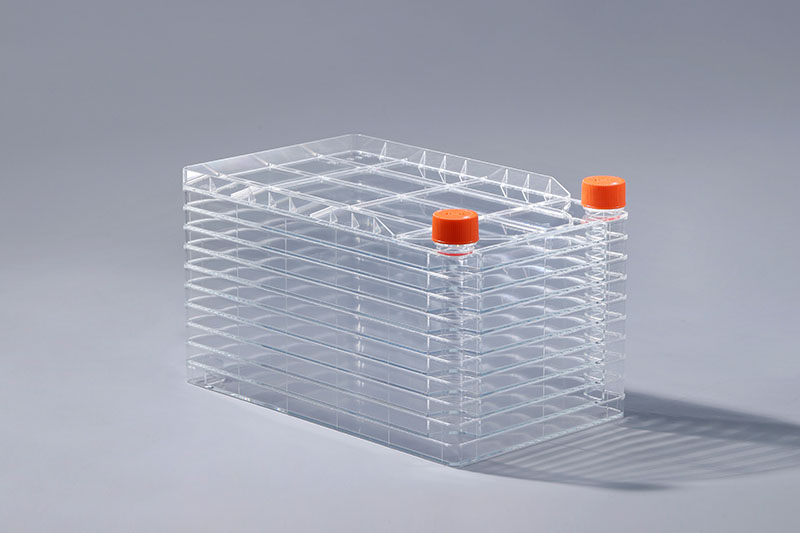세포 배양은 세포 생물학 연구 방법에서 중요하고 일반적으로 사용되는 기술입니다. 세포 배양을 통해 많은 수의 세포를 얻을 수 있으며 세포 배양을 통해 세포 신호 전달, 세포 동화 작용, 세포 성장 및 증식을 연구할 수 있습니다. 대규모 세포 배양에서 세포 공장은 주로 Vero 세포, HEK 293 세포, CAR-T 세포, MRC5, CEF 세포, 돼지 폐포 대식세포, 골수종과 같은 다양한 부착 세포의 배양에 적합합니다. 세포, DF-1 세포, ST 세포, PK15 세포, Marc145 세포 및 기타 부착 세포. 또한 CHO 세포, 곤충 세포, BHK21 세포 및 MDCK 세포와 같은 현탁 세포의 정적 배양에 적합합니다.은 효율적이고 일반적으로 사용되는 세포 배양 소모품입니다. , 10개 층, 40개 층 등. 특수 접착 공정으로 층을 연결하여 제품의 견고함을 보장합니다. 용기 표면의 친수성을 향상시키고 세포 성장 및 번식에 보다 적합하게 만들기 위해 이 소모품은 특수 표면 처리를 거쳐 소수성 표면에 친수성 그룹을 도입하여 세포 접착력을 향상시키고 낮은 농도의 세포가 쉽게 접착 특성은 벽에 달라붙습니다.
대규모 세포 배양에 세포 공장을 사용하면 공간을 절약하고 인력을 절약할 수 있으며 더 큰 배양 면적을 가질 수 있는 반면 세포 오염 가능성을 줄입니다. 백신 개발 및 세포 산업 생산에 널리 사용됩니다.
The cell factory is mainly suitable for the culture of a variety of adherent cells, such as Vero cells, HEK 293 cells, CAR-T cells, MRC5, CEF cells, porcine alveolar macrophages, myeloma cells, DF-1 cells, ST cells, PK15 cells, Marc145 cells and other adherent cells. It is also suitable for static culture of suspension cells such as CHO cells, insect cells, BHK21 cells and MDCK cells.
Using cell factories for large-scale cell culture can reduce space, save manpower, and have a larger culture area while reducing the possibility of cell contamination. It is widely used in vaccine development and cell industrial production.
The FAI climbed 5.9 percent year-on-year in the first 11 months of 2018, quickening from the 5.7-percent growth in Jan-Oct, the National Bureau of Statistics (NBS) said Friday in an online statement.
The key indicator of investment, dubbed a major growth driver, hit the bottom in August and has since started to rebound steadily.
In the face of emerging economic challenges home and abroad, China has stepped up efforts to stabilize investment, in particular rolling out measures to motivate private investors and channel funds into infrastructure.
Friday's data showed private investment, accounting for more than 60 percent of the total FAI, expanded by a brisk 8.7 percent.
NBS spokesperson Mao Shengyong said funds into weak economic links registered rapid increases as investment in environmental protection and agriculture jumped 42 percent and 12.5 percent respectively, much faster than the average.
In breakdown, investment in high-tech and equipment manufacturing remained vigorous with 16.1-percent and 11.6-percent increases respectively in the first 11 months. Infrastructure investment gained 3.7 percent, staying flat. Investment in property development rose 9.7 percent, also unchanged.
 English
English



















































